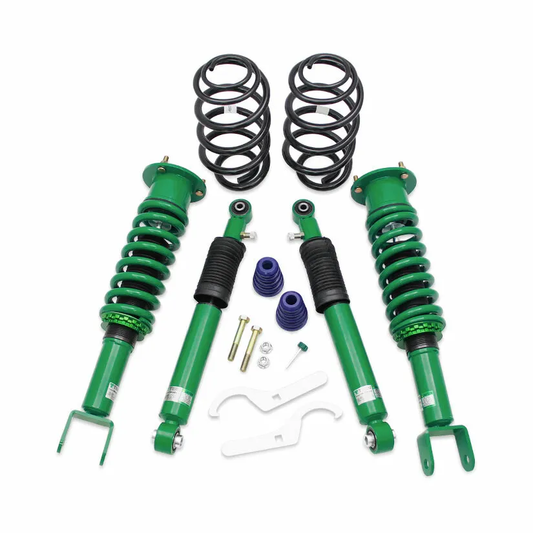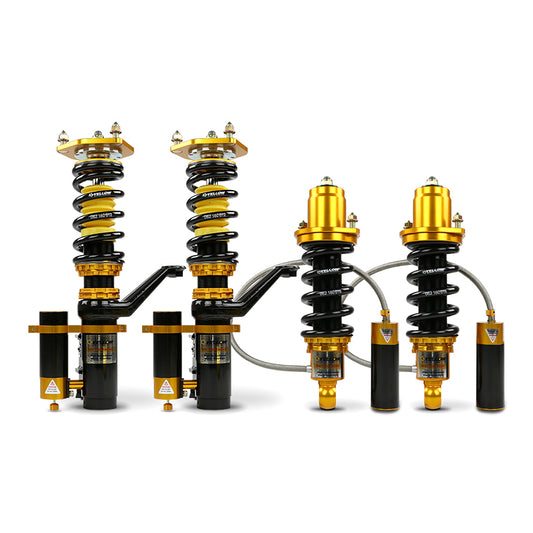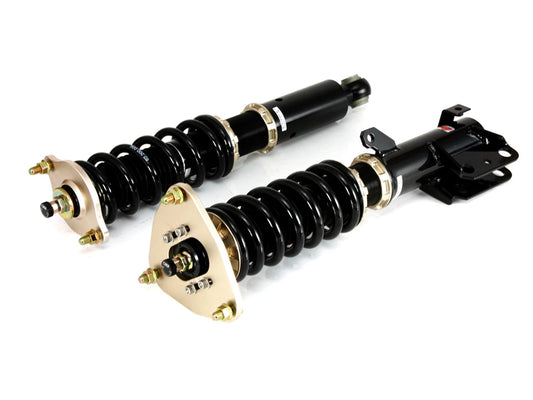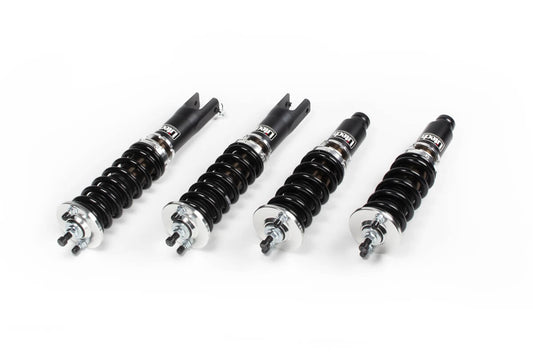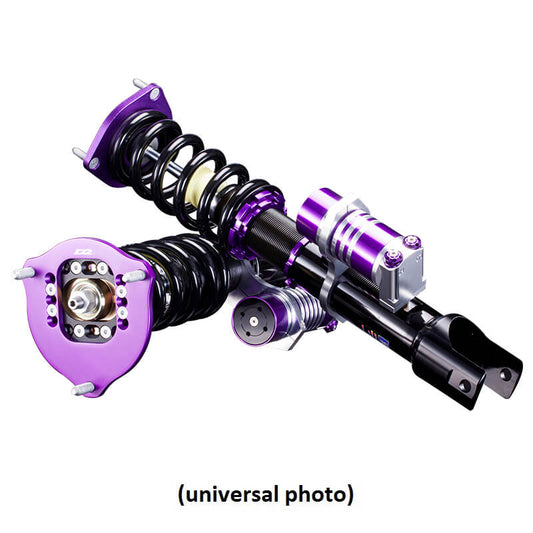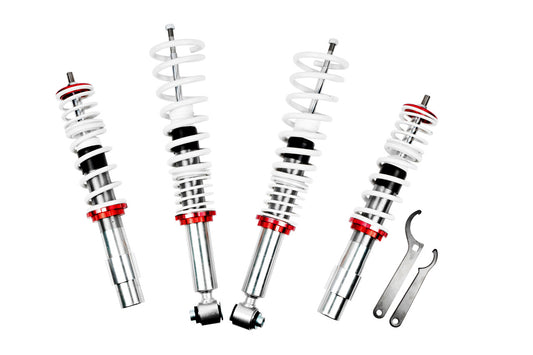
Alex Petrov
24.02.2024 год.
80% of the look of the car is the wheels. Once you decide to get cool wheels, you enter a sea of countless possibilities. Naturally you like one model on Google and … will it work on the car and what should I know?
We'll start with the wheels and move on to the tires until you're satisfied with the overall picture. It's good to know the basics before we go down. The most important characteristics of a wheel are:

ET - offset - the smaller, the more the wheel sticks out and vice versa
J - width
Need more knowledge? Contact us and Yoda will consult you
Each car has a factory specification, how wide a wheel can fit between the fenders. You can find them on Google. The width, however, is affected by the offset - or it can be a wider wheel but tucked further into the suspension.

Let's take the above two pictures. We look at the green and orange rectangle and the shock absorber. The black lines are the tires that are not important at the moment. The orange rectangle is a jana with a width of 7J, the green one is 10J. In the first photo, both wheels are with ET50. It is clearly visible that the wider wheel goes to the shock absorber, and it is not desirable that they touch. In the second picture we have the same widths, but on the green ET20 wheel, which moves it the same distance from the shock absorber (safety++).
If the orange one doesn't stick out or doesn't come out of the fender, the green one will surely come out. You already know that you can put on a slightly wider wheel than the factory one and tuck it into the shock, but don't overdo it. For example 7J(orange) and 8.5J(green) in the first picture. We increase the offset of the ET55's wider wheel and get a more compact wheel that doesn't get in the way or stick out of the fender.

The wheel is not enough for the look you envision. A beautiful wheel with a tractor tire never looks good. We will start with the wheels and move on to the tires so that the overall picture satisfies you.
There are many factors when buying wheels and tires, everything from the tune-up of the car to whether the car has had major repairs such as replacing rear eyebrows and so on matters.
Every millimeter counts and every degree of camber is the difference between a perfect fit and a flat tire or fender, which we all want to avoid. Ps. The tires of the cars stand vertically firmly on the asphalt ⇒ _|. The camber is an additional tool that allows the wheel to be tilted inward towards the fender. In this way, the tire is no longer completely vertical on the asphalt, but at an angle ⇒ _/
The desire for wheels and tires can be considered in 3 categories:
- Everyday Cars
- Track Cars
- Show Cars
Everyday Cars
In order to achieve the best result, the following things are taken into account:
- Not resting anywhere on the body or fenders
- Riding decently as for our end of the world
- Decent price as a complete set
- Fitment to be up to par of course
- Better handling on the road
- Minimal modifications to the car to complete the assignment
In this case, whether the car has the standard suspension or not, it doesn't matter. We are mainly guided by the original tire/wheel size as a package and will stick to it as close as possible so as not to spoil the suspension geometry, driving feel and ride quality. Before anything else it is good to know what space you have or in other words - what wheels can fit under the fender as much as possible.
Easiest achieved with measuring devices. Once we have clarity, it's a good idea to try several sizes of flanges and wheels to get an idea of the desired final look. the tire anywhere on the body, fenders or the fenders themselves.
Most times the bigger wheel would cost more, but it always looks better. Compared to the above example, it is possible to use a wheel with dimensions 16x7J and a tire 205/45 R16. This results in a 4mm difference in overall diameter between the two features. Other than that 4mm there will be no difference in mileage and no chance of this setup resting anywhere if the offset(ET) of the wheels is the same.
Once we have that ground, we know for sure what wheel parameters will work for us. This helps us compare different tire and wheel combinations to achieve the desired look.
Let's say we've selected the wheel and tire row. For example, a 195/50 R15 or 205/50 R15 tire is effectively identical with a minimal difference in width. The big difference comes from the price as between these two sizes it is about 50% for the Toyo TR1 tire. If we put a wheel with parameters 15x7J, there is no difference in the two setups, but in one case the tires are 400 BGN and in the other they are 600 BGN, which does not make sense.
Pros:
- Final look
- Lower tire has less flex
- Better cornering feel
- Better acceleration feel
- Better feeling when reducing speed
Cons:
- More expensive
- Heavier wheels
- Higher fuel consumption
- Lower mileage
- Worse comfort
- Possibility of easier distortion of the wheel in a bump
In the event that you fancy a much deeper (wider) wheel that can't fit in the fender of the car, there are a few tweaks that can help. On most cars, the fenders have a lip that can be rolled or cut without damaging the overall appearance of the body. Otherwise, if the car has 0 degrees of stock camber, it can be added to 1.5/2.0 which is acceptable for a street car. This will not affect tire wear much.
Here's an example of when camber would be appropriate - the above overall size for 15x7J and 195/50 R15 is 586mm in diameter, where every added 1 degree of camber frees up 10mm of fender-to-fender clearance. In short, if we have 15x7J ET30 wheels at 0 degrees of camber and we replace them with the same ones, but with ET20, they will already be 10mm further out towards the fender.
Adding -1 degree of camber, we will measure the wheel by exactly 10mm and there will be no visible difference from the top side of the tire to the fender. On the lower side (towards the asphalt) it will have stepped wider, which is better for the ultimate stability of the car at high speed
Track Cars
In order to achieve the best result, the following things are taken into account:
- Wider step overall on both axles of the car
- Wider and stickier rubber to provide more traction
- Larger diameter wheels to there are options for future upgrades to the braking system
- Again we have zero tolerance for the tire resting on fenders and other elements
- Fitment should also be up to par though
Price is again a factor, but in this case suspension components may also need to be upgraded to achieve maximum results When preparing a car with serious modifications whether it will be just for the street or the track , our main goal is maximum traction improvement. In order to achieve the best, in most cases, not only adjustable suspension height, stiffness and pre-load is required, but it is also highly recommended that the car has everything necessary for camber and toe to be adjusted according to the set-up that will be does.
With these cars, there are many more factors to consider before making a decision and writing on wheels and tires. Here, not only in a straight line and light turns, they must not rest the tires and wheels in the various components of the car, but everything must be properly adjusted in relation to the body, carriers and suspension.
Tests should be done under full suspension load and full front cornering. This is necessary because in quite extreme cases, such as when the car drifts at high speed and the tire accidentally rests on the fender, it will act as a brake. This only leads to a complete loss of control. It is strongly recommended that it be tested under full load so that it does not touch anywhere on the body.
This avoids flat tires in case of off-track mowing when the suspension is expected to work to its maximum travel on uneven surfaces. After we have reviewed the car with what parts and suspension it has, we can tell you with much higher certainty what is needed to achieve the ultimate goal.
In case of need for additional improvements to the car, you have the following options:
- Fender roll
- Camber
- Widebody kit
Show Cars
This type of car is the rarest, most difficult to perform, and the most modified. We epitomize it as the perfect stand whether on static or air suspension.
More affordable versions in show car parts offer height adjustment, roll fenders with an order of beautiful wheels and tires. This is enough to have a beautiful car.
For cars in the air, by a perfect stance we understand when it is launched at the lowest height, the lip of the wheel should be millimeters from the edge of the fender.
In order to achieve the best result, the following things are taken into account:
- Need to roll fenders and most likely repaint after that
- More camber, will also have uneven tire wear and reduced traction
- More tire stretch , there will also be a deterioration in the comfort of the car and a reduction in traction
- Show cars are mainly with premium parts and high quality service
Fitment doesn't make the car, but it is the perfect finishing touch to your project, bringing it to 100% of its potential, whether in terms of looks or performance on the road or track. You can think of fitment as the 1% that has as much effect as the other 50% of your car's build.
We own a car in every category and although it doesn't seem complicated, at the beginning it took us 1 year for each one to know what we want and do. The theory ends with the clip, everything else is experience. We'll be happy to take the time to look at your desired outcome and help you achieve it!
Shoot more fitment questions







